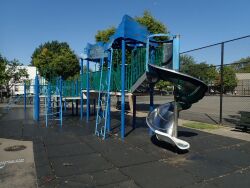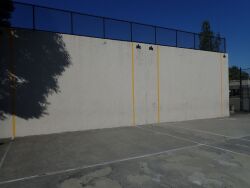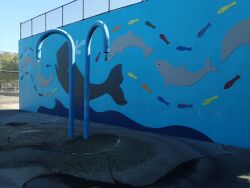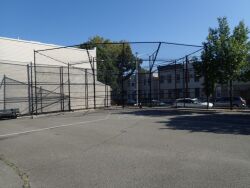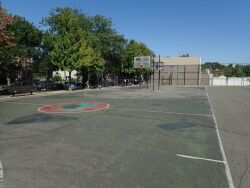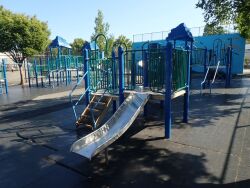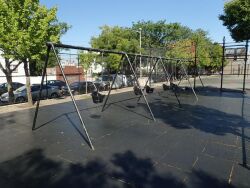"Uncle" Vito F. Maranzano Glendale Playground
"Uncle" Vito F. Maranzano Glendale Playground
What was here before?
This area was farmland for much of the 19th century. In 1885, the Newtown Board of Education opened School No. 13, the Glendale Union Free School. A larger school building was erected on the site in 1893. When the five boroughs were incorporated in 1898, the school came under the jurisdiction of the City of New York Board of Education and was renamed P.S. 67. Its principal from 1893 to 1915 was John Wesley Drumm (1862-1930), for whom nearby Drumm Triangle is named. After P.S. 91 was built a few blocks to the east in 1915, the P.S. 67 building provided facilities for students with disabilities and later served as an annex for Bushwick and Grover Cleveland High Schools.
How did this site become a playground?
In 1940-41 Parks acquired the school property and an adjacent parcel for a new playground, which opened in 1942 as Glendale Playground. On the cleared site, laborers from the Federal Works Progress Administration built handball and basketball courts, a softball diamond, play equipment, and a public restroom. A renovation in 1996 installed maritime-themed play equipment at the playground including whale, dolphin, and fish figures mounted on a wall, a concrete whale play sculpture and a spray shower.
In 2001, the playground’s ball field was named in honor of Richard Koehler. Koehler was active in many of Glendale’s civic groups and coached local children at the Ridgewood Glendale Middle Village Maspeth Little League for more than two decades before his death in 2000.
In 2007, the playground was renamed “Uncle” Vito F. Maranzano Glendale Playground.
Who is this playground named for?
This playground honors Vito Frank Maranzano (1923-2006), longtime Glendale resident and neighborhood activist.
Born in Italy, Maranzano immigrated with his family to Bushwick, Brooklyn. He served in the Navy during World War II and moved to Glendale afterward.
He was a member of multiple organizations in the neighborhood, including as president of Glendale Property Owners Association, Greater Ridgewood Restoration Corporation and the Ridgewood Local Development Corporation. He was also active in the Kiwanis Group of Glendale, the Glendale/104th Precinct Civilian Observation Patrol (GCOP), UNICO International and had served as chairman of the Community Board 5 Public Safety Services Committee.
Glendale Playground is named for the neighborhood in west central Queens. In 1860, George S. Schott acquired property in the area known as Fresh Pond and renamed it for his birthplace in Glendale, Ohio. With the arrival of the South Side Railroad in 1867 and steam-powered transportation in 1893, row houses and single-family residences gradually displaced local farms. During the first half of the 20th century, the neighborhood attracted a substantial German immigrant population and new industries, such as breweries, textile factories, and film studios. More recently, immigrants from Eastern and Central Europe, the Caribbean, and Asia have settled in the area.
Check out your park's Vital Signs
Clean & Safe
Green & Resilient
Empowered & Engaged Users
Share your feedback or learn more about how this park is part of a
Vital Park System

